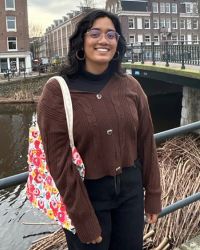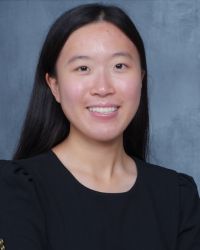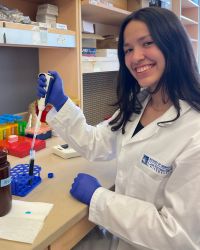If you’re looking to be inspired by the incredible work happening at Case Western Reserve University and in the local Cleveland area, you need not look far. Tomorrow (Thursday, Aug. 1), more than 110 presenters from various universities, colleges and high schools will present at Summer Intersections: CWRU Undergraduate Poster Session, hosted by the Undergraduate Research Office.
During this event, members of the CWRU community and other locals will have the opportunity to interact with an array of research and creative projects conducted by students from across all disciplines—from arts and humanities to engineering, life sciences, physical sciences and social sciences. University summer programs with presenters also include Advanced Platform Technology Center, Greater Cleveland Partnership, Harrington Discovery Institute and INSPIRE-US Program.
To get a glimpse of what attendees can expect, The Daily spoke with three students who will be presenting their work. Read on to learn more about their projects—and make a plan to attend Intersections between 10 a.m. and noon at Tinkham Veale University Center.
Answers have been edited for clarity and length.

Shejuti Wahed
Rising fourth-year student majoring in neuroscience and psychology, with minors in bioethics and medical humanities and chemistry
- Tell us about the project you’ll be presenting!
My project, titled, “Culture Change and Practical Considerations for Sustainability in Research,” is an initiative to make sustainability on campus more accessible to students, [faculty and staff members], and laboratories alike. Our project is working to change systems and reduce the extra effort that it takes to act sustainably.
One part of this project is expanding Climate Action Week to Climate Action Month and involving student organizations and centers around campus in planning events throughout October to facilitate climate consciousness and action over a greater period of time. The other part is expanding our lab greening program, which recycles and repurposes unused equipment from campus buildings and labs to include non-chemical surplus and make it easier to dispose of waste in an environmentally conscious way.
- What do you enjoy most about working on this project? What kind of work/research went into it?
My favorite part of this project has definitely been the incredible people I have met in all kinds of areas and exploring all of the sustainability work that goes on behind the scenes at our university.
For Climate Action Month, we have been working with so many organizations that are not necessarily directly tied to climate, but have intersectional goals in furthering environmental initiatives. For example, Know Your Neighbors is a student club primarily dedicated to strengthening ties between CWRU and surrounding communities, but climate action is an intersectional mission of theirs because environmental issues affect us all collectively. Meeting the organizations across campus that conduct incredible work has been so inspiring and has further fueled my commitment toward social and environmental activism.
- Can you describe your experience with your CWRU faculty mentor? How did they contribute to your overall project?
[Ina T. Martin] has been an incredible guiding force in my sustainability interests. Her passion for climate action is evident in her work, which she pursues alongside all of her research and teaching and [Interdisciplinary Science and Engineering Building] planning. She always says she has a vested interest in the future of this world because of her two young children, but it is incredible seeing the amount of genuine effort and action she puts into committing to this statement.
I first met Dr. Martin years ago for advice on the Undergraduate Research Society’s lab coat lending program, and since then she has served as such a wonderful mentor to me and has helped me facilitate connections that further my sustainability work. She has provided so much support in the organizing I do for Climate Action Month, and is always there for me in answering my endless day-to-day questions.
- Why do you believe students should get involved with Intersections?
Intersections is such a valuable opportunity for undergraduate students to get comfortable speaking about their own work and connecting on a one-on-one level with others interested in research. You get to speak to people of all levels of familiarity with your subject—from other students and faculty in completely different departments to experts in your field. You also get the chance to explore your peers’ projects and discover all of the exciting work being done on campus you may not have otherwise heard of!

Gloria Liu
Rising fourth-year student majoring in biology and finance
- Tell us about the project you’ll be presenting!
Ethanol exposure during pregnancy can lead to the development of Fetal Alcohol Spectrum Disorder (FASD), a condition manifesting in behavioral impairments and structural brain abnormalities like cerebellar hypoplasia. L1 cell-adhesion molecule (L1CAM) is a critical molecule for brain development, and its function is dependent on lipid rafts (LR), which are microdomains of the plasma membrane. Ethanol impairs L1 trafficking occurring in and out of the LR, impairing the downstream cascade normally leading to neurite outgrowth.
My project focuses on choline-sufficient animals because we know that infants, at least in the UH Rainbow Babies and Children’s Hospital NICU, exhibit both choline-deficient and sufficient levels, meaning some are receiving adequate levels of nutrition from external sources or the mother. If supra-supplementation yields similar effects, then we can prove choline is beneficial even for infants that are not struggling from deficiencies. Moreover, my project seeks to answer the question: “can choline mitigate the effects of ethanol in choline-sufficient neonatal rats?”
- What do you enjoy most about working on this project? What kind of work/research went into it?
I love how there’s always more for me to learn. What I’ve noticed is there’s a lot of trial and error and critical thinking involved in research. This project encourages me to think from multiple perspectives. In turn, my way of thinking is diversified and I’m able to approach problems with a more open mind.
I started working on this project this summer. The process of cerebellum homogenization, sucrose density gradient centrifugation, lipid raft separation, and dot/Western blot is repeated to determine the distribution of L1 in both lipid rafts and non-lipid rafts. After analyzing signals and performing subsequent calculations, we can make comparisons to previous data on choline-deficient animals.
- Can you describe your experience with your CWRU faculty mentor? How did they contribute to your overall project?
[Cynthia Bearer] has been an integral part of my journey at CWRU. She isn’t just my research mentor, but someone I look up to when it comes to my professional goals and aspirations. Her expertise on the subject matter I am focusing on has allowed me to understand my project far beyond the surface level. She’s helped me troubleshoot technical and conceptual problems I run into, provided ample feedback on my writing and presentation skills, and has given me the tools and resources I need to succeed. I’m honestly really lucky to have her as my mentor.
- Why do you believe students should get involved with Intersections?
Intersections is a chance to showcase your work and see what fellow classmates are working on too. Every student is working on a different project, and what better way to see what friends and peers are up to than to scope out an entire gymnasium full of research posters! Additionally, I think it’s a fantastic opportunity to condense background data and analysis to key points and to practice presenting research to an audience in just 5-10 minutes. Whether your results are significant or not, Intersections allows you to share a tangible product of the hard work you’ve been putting in.

Ana Alcocer
Rising fourth-year psychology student on the pre-med track, with minors in chemistry and political science
- Tell us about the project you’ll be presenting!
Marfan syndrome is a connective tissue disorder affecting the skeleton, eyes, blood vessels, and heart. My project consists of identifying a therapeutic intervention for Marfan syndrome to prevent aortic aneurysms and dissection, which cause significant morbidity and mortality. Through experimental examination, I have been able to observe colocalization of a protease, Adamts6, and FBN1, the gene mutated in Marfan syndrome. Adamts6 deficiency resulted in restored aortic wall structure and prevention of aortic aneurysms in a mouse model of Marfan syndrome. These novel findings suggest that inhibition of ADAMTS6 has potential for therapeutic intervention to mitigate aortic aneurysms.
- What do you enjoy most about working on this project? What kind of work/research went into it?
Working on this project has allowed me to contribute to a growing scientific field. The nature of this project consists of constant learning of scientific insight, posing critical questions, and challenging pre-existing knowledge, which is incredibly fulfilling. Advancing this research project has required extensive preparation and collaboration.
The beginning phases of this project required considerable evaluation of previous literature to immerse myself in the body of knowledge and identify questions, methodologies and previous research gaps to initiate my project. Moreover, the collaborative nature of this project has been incredibly rewarding as it has allowed me to work with a diverse and knowledgeable group of individuals who are pursuing similar goals through creative perspectives leading to innovative advances.
- Can you describe your experience with your CWRU faculty mentor? How did they contribute to your overall project?
I’ve had the privilege to work in the Mead laboratory for over a year. During this time, [Timothy Mead] has offered valuable mentorship through guidance, support, and feedback. Through regular meetings and instruction, Dr. Mead has instilled in me confidence and resilience to pursue not only my research objectives, but also my long-term career plans. Through frequent laboratory meetings and due to the collaborative environment that Dr. Mead has fostered, I had the opportunity to provide mentorship to new undergraduate and high school students, learn how to accept and provide constructive feedback, refine my presentation skills, and develop project management skills.
- Why do you believe students should get involved with Intersections?
The CWRU Summer Intersections program is an exciting opportunity to expose students to a growing body of biomedical research. Early engagement in scientific exploration is key to furthering students’ academic and professional paths. This interdisciplinary program allows students to learn about diverse research methods and findings, enabling them to consider research questions from various perspectives and learn to integrate knowledge from multiple fields.

